This is my finished dress.
Again, my original inspiration is a modcloth dress.
 |
| Source |
I’ve been wanting to do this dress for a while, and it just fits the theme, doesn’t it?
(I apologise for the quality of some of the photos. Almost all of my pattern alteration was done at night, so there was no natural light, and as my overhead light had blown, most of the light was from my desk light, supplemented with the flash. And, I'm still learning yo use my stylus.)
So, my pattern alteration.
I firstly thought through the steps I needed to take to alter this pattern. Please forgive my fairly bad drawing skills. The point was simply for me to think about the steps I needed to take to alter the pattern.
So that I could reduce the amount of time it actually took to alter the pattern. I also almost fully wrote out these instructions so that I would remember to photograph everything, and to think through the process of pattern alteration and construction.
The dress is essentially a wrap dress made from a woven fabric with piped neckline edging, a mid-waist button closure, 10cm midriff band, triple layered skirt and yoke.
So, the bodice alterations.
Mark all seam allowances on your bodice pieces.
Take your centre front piece. My pattern piece has a curved neckline, but for this dress, I want a V neckline. I want the V to cross lowish, about 5cm above my nipple line. High enough that I won’t be afraid of flashing the world each time I wear it, but low enough to be flattering (side note: I have a large bust, so V neck lines are very flattering, and although they draw the eye downwards, can have the effect of making the bust appear smaller. If the V stops above the nipple line. Any lower than the nipple line, and it tends to make my bust look huge. Which is good in certain situations, but not really what I’m going for here.) Your original pattern piece should have had a bust line marker. Usually, this is a circle with a cross on it. It tends to have the finished garment measurements near it. Extend this mark to the centre front seam, and mark a point 5cm higher.
Draw a straight line from the point where the neck and shoulder seams overlap to the mark you made above your bust. Using the point where the seams overlap at the shoulders will ensure that your shoulder seams overlap properly when you go to sew your altered pieces.
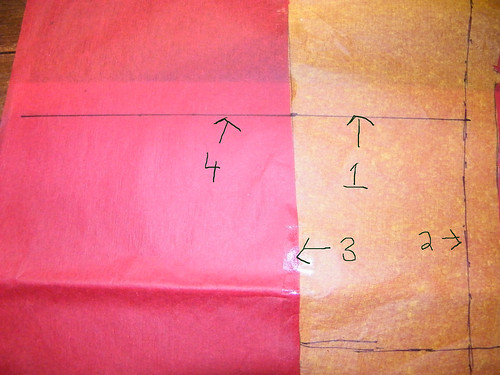 |
| 1. Line drawn 10 cm from waist seam (midriff line). 2. Side front seam 3. Centre front seam 4. Continuation of midriff line, 13cm past centre front seam |
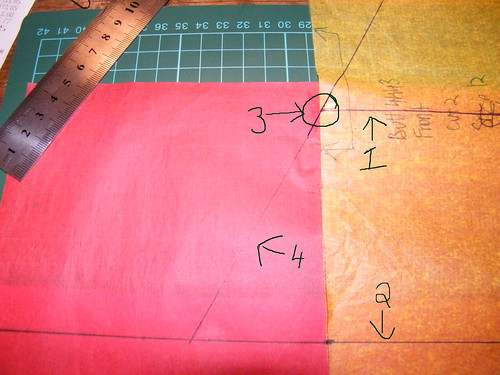 |
| 1. Bust line. 2. Midriff line. 3. Where the midriff line mets the neckline 4. Continuation of neckline. |
 |
| 1. Where neckline meets midriff line 2. Waistline 3. This line is 10cm long |
Next, we are going to create the midriff band pieces. I want the midriff band to be 10cm wide. So, I am going to mark 10cm from the waist seam along both seams on each of the centre front, side front, side back and centre back pieces. Cut along this line.
 |
| Arrows marking midriff line, drawn at 10cm from waistline |
 |
| Cut along line, you will be left with 4 pieces that look like this |
Laying the upper section aside, I am going to join the midriff pieces. Take your centre front and side front pieces and overlap them at the middle seam.
 |
| Line up the seams |
 |
| Pieces taped together |
Trace around this piece, adding the 1.5cm seam allowance on the top edge, and the centre edge. Mark this piece ‘midriff band front.’
 |
| Mark front and side on finished piece |
Repeat for the back pieces. Label ‘midriff band back.’
 |
| Finished midriff band pieces |
Take the measurement you noted down above (mine was 5cm, remember?) Double this. Take your front Midriff piece, and measure from the centre edge your measurement on the top and bottom seams, and mark. Join the marks. This is your placement line.
 |
| Add placket placement line |
 |
| Placket |
Next, we are going to created the yoke on the back. I want my yoke to hit the armscye in the middle (where the princess seam currently hits), and the curve to drop down 5cm lower at the centre back. So, taking the centre back piece, draw a line straight across from the princess seam to the centre back seam. Mark the point 5cm lower.
 |
| 1. Where princess seam meets armscye 2. Line straight across to centre back seam 3. 5cm below straight line from armscye |
Draw a curve between the two points. I used a French Curve to do this. I firstly drew a curve that sat below my line i drew from the armscye to the centre back, but I didn't like the look of it. So, I placed the French Curve so that the curve went above the line from the armscye to the centre back seam. This looked much better.
Cut along this line, so you have a yoke piece and a centre back piece.
 |
| Back yoke piece with seam line marked |
Now, take your centre back piece and side back piece. We are going to join these together, but because the seam line includes shaping, they won't join perfectly. I want gathers that sit under the yoke, and a smooth seam at the midriff. So, the gap left from overlapping the centre back and side back seam lines should be at the top.
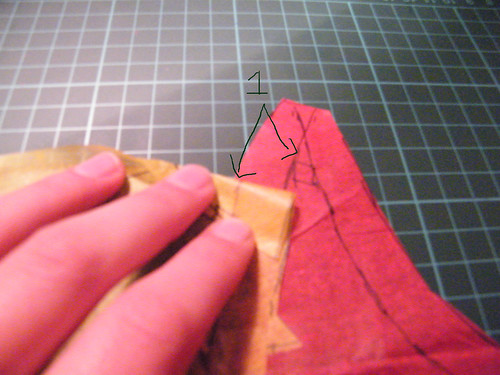 |
| 1. The two seam lines don't line up perfectly |
 |
| Seams that don't overlap perfectly. But that's okay. |
Now, I’m going to add my gathers. I want use a 1.75 gather at the yoke. So, measure the top of the yoke. For me, this was 25cm. Using a calculator, times that measurement by .75. For me, this was 18.75cm. That is how much we are going to be adding to the top seam line.
Now, take your back piece, and mark 7 even lines.
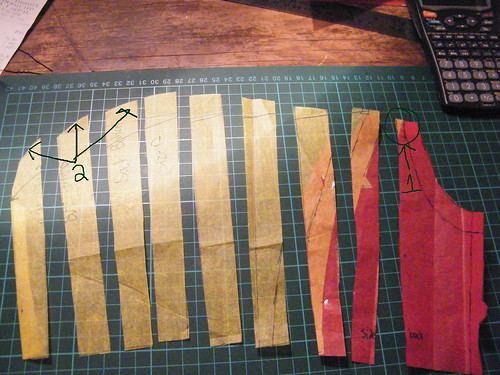 |
| 1. Start your first line straight down from the armscye to the waist seam. 2. These pieces probably should not have been split, and left me with the weird puffy back growth. |
When I first did this, and I drew 7 even lines, and spread them. the problem with this was that I ended up with some ugly puffy gathers around the point of the yoke, which made me look like I had a weird growth coming out of my back. Not pretty.
(This is what I did the first time: Because there are 7 gaps, we need to divide the amount we are adding by 7. For me, this was 2.6 cm. Tape your first piece down at the top. Take the second piece, and hold the midriff band points next to each other. Line the top points up so that they are your calculated distance apart.
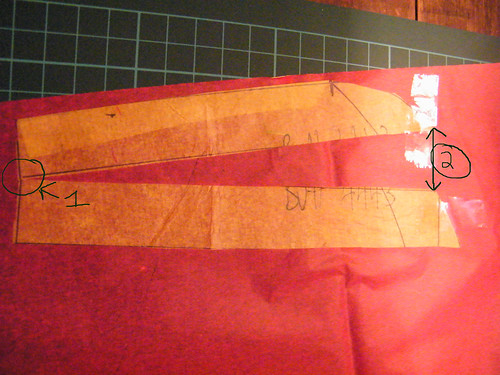 |
| 1. Keep midriff seam together. 2. This is my gather of 2.6cm |
 |
| 1. Again, these should have been kept together) |
When I redid this, I took my originally altered piece, and taped the first two and last two pieces together. This meant that the gathers were starting as the curve levelled out, and reduced the weird-back-growth- look.
 |
| I re-split the pieces, keeping the three centre pieces, and the two side pieces together. |
This also left me with 5 gaps to use, not 7. So, I divided my 18.75 by 5, which gave me 3.7cm. Using the same technique as before, I made sure the lower seam line matched up, and added 3.7cm between each of the pieces.
 |
| Trace exactly around your pattern piece, then add the 1.5cm seam allowance to the bottom and top seams |
Then, trace the pattern pieces, adding a 1.5cm seam allowance at top and bottom. I also drew the seam line along the gather to make placement easier when I get to sewing the dress.
 |
| Back piece with top seam allowance marked. |
You’re now done with the back pieces (yay!). Time to move on to the front.
We have already removed our midriff band, so the next step is the front yoke.
Again, I want the front yoke to hit the armscye at the princess seam line.
So, take your centre front piece. Draw a line from the princess seam at the armscye to the neckline.
 |
| Add caption |
Cut along this line. You will now have a centre front, side front and top front piece.
 |
| Side front piece, centre front piece and tope (front yoke) piece. |
Take the top front piece. We’re not quite finished with the front yoke yet. Mark the point along the lower edge halfway between the neckline and your line from the shoulder. Draw a line from this new point to the shoulder seam.
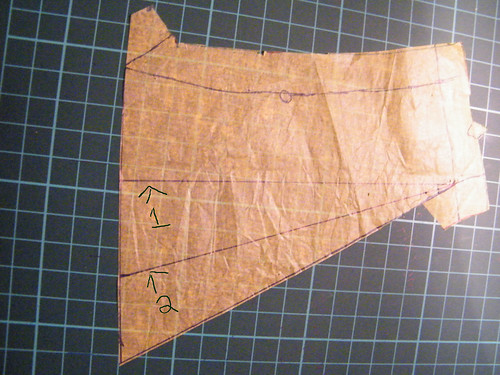 |
| 1. Line straight from shoulder seam to line. 2. Line from shoulder seam to half way between straight down line and neckline |
 |
| Place your coin so it touches you middle line and the lower line |
 |
| Draw around your coin to add a curve |
Now, trace around the front top piece, adding seam allowances at the neckline and midriff seam. I also mark the seam line of the neck/midriff, so that I know exactly where I will be sewing my curve. Mark this piece ‘front yoke.’
 |
| Finished front yoke piece with seam lines marked Take your front pieces. |
Line the seam lines up from the top. There will be a decent gap on the lower edge. This is okay, because we are going to be adding gathers.
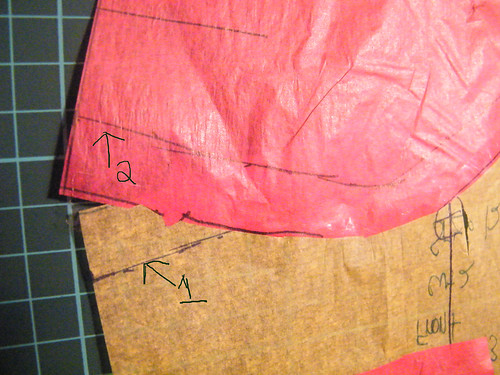 |
| 1. Centre front seam 2. side front seam. They don't line up. That's okay |
 |
| Front pieces with not-lining-up seams |
Measure the top seam, and using your calculator, times the number by .75. For me, my measurement was 11cm, and after I timesed it by .75, my measurement was 8.25cm.
Do the same for the top measurement. For me, the measurement was 24cm, so my gather was 18cm.
We will be cutting the bodice piece into 6 pieces (5 cutting lines).
 |
| 1. (upper edge) and 2. (lower edge) are not the same measurement. |
As with our back piece, I will tape the first piece down.
Now, this is slightly more tricky that the back piece, because you have to make sure the top and bottom measurements are correct before you tape the next one down.
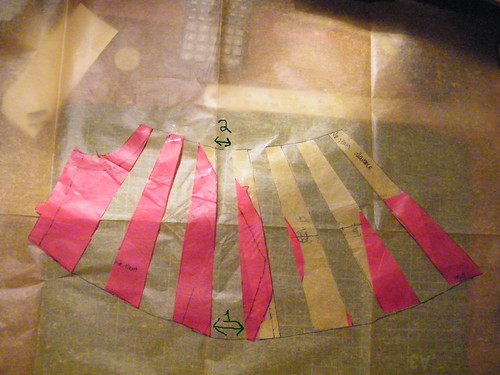 |
| 1. lower gather amount, 3.6cm 2. upper gather amount, 1.65 cm |
 |
| Front piece with seam lines marked. |
Yay! That's all of the bodice piece alterations.
Next, we are going to alter the skirt.
I have an A-line skirt pattern, as well as a full pleated skirt pattern, but neither of those fitted what I was going for in this dress. I was after a more gathered look.
So, we will create totally new pieces. They will essentially be a big rectangle/tube thing.
First take your hip measurement. For me, this was 100cm Now, you could halve this to get the front and back measurement, and then double it (I want a 2 x gather for my skirt) to get the final measurement, but unless you are doing a different gather, you don’t really need to bother. Your waist measurement for the front or back piece will simply be your total hip measurement.
Next take the skirt length measurement. For me, this was the distance from my waist to knee, or 55cm.
Your back skirt piece is going to be a rectangle your total hip measurement by your skirt length measurement. If you halve the waist measurement, you will be able to make a smaller pattern piece, so long as you remember to cut it on the fold. Add 1.5cm seam allowances, and mark this piece ‘skirt back.’
Next is the skirt front. Like the midriff, it’s going to overlap. Go back and find your overlap measurement. For me, this was 10cm. You want to draw a rectangle that is half your hip measurement plus your overlap measurement. Make sure to mark the hip measurement. This is the centre front line. Along the hemline, mark the half way point. So, for me this was 50cm + 5cm = 55cm.
I want the split/overlap to finish 15cm above the knee/hemline. So, mark the point you want the skirts to overlap, from the hemline on my centre front line. Draw a curve from the waist to the overlap point.
Continue this curve down. I increased the curve angle a lot at this point, to the halfway point you marked on the hemline earlier. Try to keep the curve as smooth as possible.
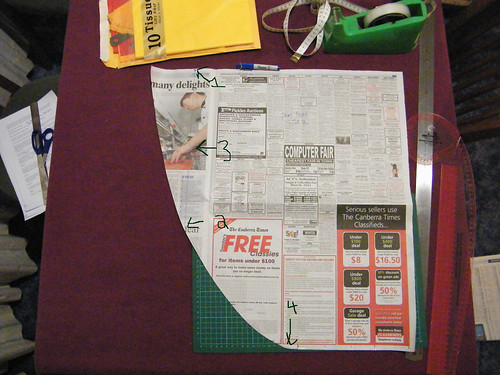 |
| 1. centre front mark 2. Mark 15cm above hemline 3. Straight line from centre front to hemline 4. halfway between side seam and centre front |
Take a sleeve pattern. It actually doesn't matter if it is a stretch pattern or not, because we are going to be adding puffy-ness to the sleeve, so it will fit in your armscye.
 |
| Sleeve pattern |
 |
| Mark 7.5 cm from the arm seam on both of the inner arm seams. (I also marked 6cm). |
 |
| Shortened sleeve pattern |
 |
| Line perpendicular to hem. I used the lines on my cutting mat to help me. |
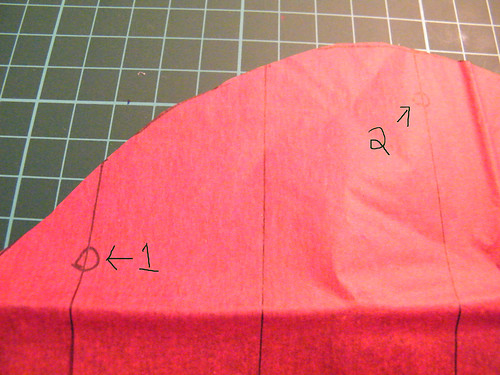 |
| Make sure your lines go through the dots. |
Cut along these lines and, like in the front piece, spread the pieces. You will spread these piece evenly. I put 2cm between each piece. The lower edge of the pieces should be kept on a straight line.
 |
| Spread our pieces, keeping the bottom edge consistent. |
Using a french curve, draw a new curve for the sleeve.
 |
| Using a French Curve, redraw the sleeve cap |
Trace over this, adding dots and notches to your final piece.
 |
| Mark dots and notches |
Congratualtions! You've now finished the pattern alterations!
Now, it's time to sew the dress. I made this dress in a day, the day that I had to wear it. I finished it 5 minutes before I left the house, 1 hour after the event started. So, I didn't take any photos of my progress.
But, a basic summary is as follows:
You will need to cut the following pieces:
Main Fabric:
Front yoke x2
Front x2
Front Midriff x2
Front Plackett x 1
Back Yoke x1
Back x1
Back Midriff x1
Skirt Front x2
Skirt Back x2
Sleeves x2
Contrast Fabric 1:
Skirt Front x2
Skirt Back x2
Piping fabric.
Contrast Fabric 2:
Skirt Front x2
Skirt Back x2
Lining: (I used the main fabric)
Front yoke x2
Front x2
Front Midriff x2
Back Yoke x1
Back x1
Back Midriff x1
Because I used a checked fabric, I wanted to match checks wherever possible. A few of the places it was important to me were:
The back yoke / back / back midriff at the centre back seam. (Careful cutting)
The placket /front midriff. (Careful cutting)
The front yoke/ back yoke at the shoulders. (Joined the pieces, eliminating the shoulder seam)
The back and front midriff. (Joined the pieces, eliminating the side seam)
So, I cut each of these carefully, or joined the pattern pieces, to ensure that the details matched.
Construction:
*sew piping
* sew piping to lower edge back yoke
* sew back to back yoke
* sew shoulder seams of back and front yoke
* sew piping to front yoke around neckline
* sew front to front yoke
* set in sleeves
* lining: sew back to back yoke; shoulder seams of back and front yokel front to front yoke
* sew neck and armscye
* turn through
* topstitch along lower yoke edges
* decoratively top stitch back yoke
* sew side seams of bodice, midriff, skirts and contrast skirts
* sew piping on placket inner edge
* sew placket in place along placement line.
* sew piping to midriff band
* hem skirt
* sew skirt to front midriff band
* sew midriff band (front and back with bodice sandwiched in between) including edge of midriff.
* sew skirt to front pin inside midriff band in place. Hand stitch down.
* topstitch midriff band
* sew buttons, button holes






No comments:
Post a Comment